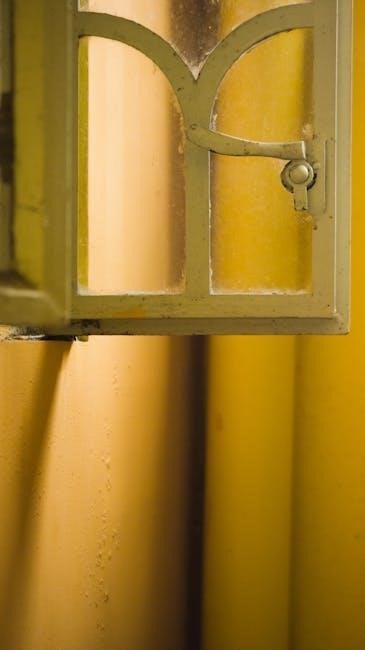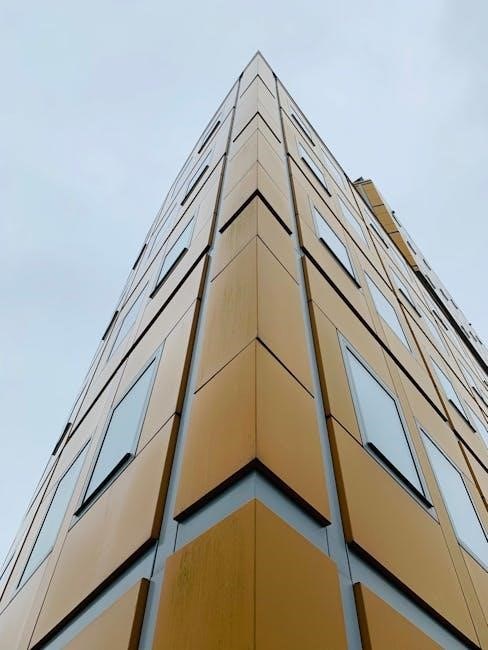This unique project combines art and math‚ engaging students in graphing linear equations using stained glass designs․ It creatively reinforces slope and y-intercept concepts‚ making math visual and fun․
1․1 Overview of the Stained Glass Window Project
The Stained Glass Window Project is an innovative educational activity that combines mathematics with art․ Students graph linear equations on grid paper using slope-intercept form‚ creating vibrant designs that resemble stained glass․ Each equation corresponds to a line with a specific slope and y-intercept‚ which students plot and extend to the edges of the paper․ After graphing all lines‚ students color the resulting sections‚ creating a visually striking stained glass effect․ This project reinforces understanding of linear equations while fostering creativity and attention to detail․ The final artwork serves as a unique assessment of their math skills․
1․2 Importance of Graphing Linear Equations in Math Education
Graphing linear equations is a fundamental skill in mathematics‚ providing a visual representation of relationships between variables․ It helps students understand slope and y-intercept‚ essential for analyzing real-world phenomena․ By plotting lines‚ students develop problem-solving abilities and spatial reasoning․ This method also bridges algebraic and geometric concepts‚ enhancing comprehension․ Graphing linear equations prepares learners for advanced math‚ such as quadratic equations and calculus․ It fosters critical thinking and applies to various fields like science‚ engineering‚ and economics․ Mastering this skill builds a strong foundation for future academic and professional success․

Understanding Slope-Intercept Form
Slope-intercept form (y = mx + b) is a linear equation format where m represents the slope and b is the y-intercept․ It simplifies graphing lines․
2․1 Definition of Slope (m) and Y-Intercept (b)
The slope (m) measures the steepness of a line‚ while the y-intercept (b) is where the line crosses the y-axis․ Together‚ they define a line’s equation in slope-intercept form․
2․2 Role of Slope in Determining Line Steepness
The slope (m) determines the steepness and direction of a line․ A positive slope indicates the line rises from left to right‚ while a negative slope shows it falls․ The greater the absolute value of m‚ the steeper the line․ For example‚ a slope of 2 creates a steeper line than a slope of 1․ In the stained glass project‚ understanding slope is crucial for accurately graphing lines and creating visually appealing designs․ This concept helps students visualize how changes in slope affect the overall appearance of their artwork․
2․3 Role of Y-Intercept in Line Positioning
The y-intercept (b) determines where the line crosses the y-axis‚ establishing its vertical starting point․ This value is critical for accurately positioning the line on the graph․ A positive y-intercept places the line above the origin‚ while a negative y-intercept positions it below․ In the stained glass project‚ correctly identifying the y-intercept ensures the line aligns properly with the design․ Students learn how changes in the y-intercept shift the line vertically‚ enhancing their understanding of linear equations and their visual representation in artistic designs․
Graphing Linear Equations
Graphing linear equations involves plotting points and drawing lines based on slope and y-intercept; This visual method helps students understand and interpret equations effectively in creative designs․

3․1 Steps to Graph a Line in Slope-Intercept Form
- Identify the slope (m) and y-intercept (b) from the equation y = mx + b․
- Plot the y-intercept on the y-axis․
- Use the slope to determine the next point by moving m units up/down and 1 unit right/left․
- Draw a straight line through the plotted points․
- Extend the line to the edges of the graph paper․
- Color the section corresponding to the equation for visual distinction․
- Verify accuracy by comparing with the colored answer key․
This method ensures clarity and precision in graphing linear equations while enhancing visual understanding․
3․2 Plotting Points and Drawing Lines
Accurately plotting points is essential for graphing linear equations․ Start by identifying the y-intercept and plotting it on the y-axis․ Next‚ use the slope to determine additional points‚ ensuring each step is precise; Once points are plotted‚ use a straightedge to draw a continuous line through them․ Extend the line to the edges of the graph paper to maintain consistency․ For stained glass projects‚ draw lines thick enough to be visible and color-code each section according to the corresponding equation․ This method ensures clarity and helps students visualize the relationship between points and lines effectively․
3․3 Identifying Positive and Negative Slopes
Positive slopes rise from left to right‚ while negative slopes descend from left to right․ To identify them‚ analyze the rise over run․ A positive slope increases as x increases‚ while a negative slope decreases․ For example‚ a slope of 2/1 is positive‚ whereas -2/1 is negative․ In stained glass projects‚ color-coding can help differentiate: use one color for positive slopes and another for negative․ This visual distinction aids in quickly recognizing line direction‚ enhancing understanding and making the graph more engaging․ This method also helps students connect algebraic concepts to visual representations creatively․
Stained Glass Window Project Details
The stained glass project involves graphing 24 linear equations on paper‚ coloring sections‚ and creating a vibrant design․ It combines math with artistic expression creatively․
4․1 Instructions for Students
Students begin by obtaining graph paper and colored pencils․ Each equation is plotted by identifying the y-intercept and using the slope to determine additional points․ Lines are drawn to the edge of the paper‚ ensuring accuracy․ After graphing all equations‚ students color each section‚ adhering to a specified color code․ The final stained glass effect is achieved by carefully shading and ensuring vibrant colors․ The completed project is then compared to the answer key to verify accuracy․ This creative process blends mathematical precision with artistic expression‚ fostering a deeper understanding of linear equations while encouraging creativity․
4․2 Color Coding and Design Elements
Color coding is essential for distinguishing between lines and enhancing the stained glass effect․ Each equation is assigned a specific color‚ ensuring clarity and visual appeal․ Positive slopes are colored differently from negative slopes‚ aiding in quick identification․ Students use vibrant hues to fill sections between lines‚ creating a mosaic-like design․ The color key provided in the answer key helps students verify their work․ This method not only reinforces mathematical concepts but also encourages artistic expression‚ resulting in a visually stunning and educationally meaningful project that combines creativity with academic rigor․
4․3 Assessing Student Understanding
Assessment involves reviewing the accuracy of graphed lines and colored sections․ The answer key provides a visual reference to verify student work․ Teachers evaluate the correctness of slopes‚ y-intercepts‚ and line extensions․ Color consistency and design clarity are also assessed․ Students’ ability to distinguish between positive and negative slopes is checked through their color choices․ Additionally‚ understanding is gauged by students’ ability to interpret and explain their graphs․ This comprehensive approach ensures both mathematical accuracy and artistic execution‚ providing a holistic evaluation of student learning and creative application․

Answer Key and Solutions
The answer key provides clear‚ color-coded solutions for all graphing exercises․ It includes detailed steps and final visuals to verify student accuracy and understanding effectively․
5․1 Colored Answer Key for Visual Clarity
The colored answer key enhances visual learning by using distinct colors to highlight slopes‚ y-intercepts‚ and lines․ This clarity helps students quickly identify correct graphs and understand mistakes․ Each equation’s solution is displayed in a unique color‚ making it easier to distinguish between multiple lines on the stained glass design․ The vibrant visuals align with the artistic aspect of the project‚ ensuring both accuracy and engagement․ This feature is particularly useful for assessing student work‚ as it provides a clear‚ side-by-side comparison with their own graphs․
5․2 Solutions for Graphing Linear Equations
The solutions provide step-by-step graphs for each equation‚ ensuring clarity and accuracy․ Each line is plotted using the slope-intercept form‚ with the slope determining steepness and the y-intercept marking the starting point․ Students can follow the colored key to identify corresponding equations‚ making it easier to verify their work․ The solutions include plotting points‚ drawing lines to the edge of the paper‚ and coloring sections as specified․ This visual approach reinforces understanding of linear equations and helps students identify any discrepancies in their graphs compared to the answer key․
5․3 Verification of Correct Answers
Verification ensures accuracy by comparing student graphs to the colored answer key․ Each equation’s graph is clearly marked‚ allowing students to check their work visually․ The key’s color coding helps distinguish between different lines‚ making it easier to identify any errors in slope or y-intercept placement․ This step reinforces understanding and builds confidence in graphing skills․ By aligning their work with the answer key‚ students can quickly pinpoint mistakes and understand where improvements are needed‚ fostering a deeper grasp of linear equations and their graphical representations․

Educational Benefits of the Project
This project transforms abstract math into a tangible‚ creative experience‚ enhancing understanding and retention․ It combines art and problem-solving‚ making learning interactive and visually engaging for students․
6․1 Reinforcing Linear Equation Concepts
The stained glass project provides a hands-on approach to understanding linear equations; By graphing lines on a coordinate plane and coloring the resulting patterns‚ students visualize how slope and y-intercept determine line behavior․ This creative method reinforces key concepts like slope-intercept form and the relationship between algebraic equations and their graphical representations․ The visual nature of the project helps students distinguish between positive and negative slopes‚ as well as how changes in slope or intercept alter the line’s appearance․ This interactive learning tool makes abstract math concepts more tangible and memorable‚ fostering a deeper understanding of linear equations․ The color-coded answer key allows for easy verification and correction of work‚ ensuring students grasp foundational principles effectively․ Engaging in this project not only enhances mathematical knowledge but also connects it to artistic expression‚ making learning more enjoyable and inclusive for diverse learning styles․ Through this unique blend of math and art‚ students develop a stronger foundation in graphing linear equations while exploring their creativity․ The project’s visual outcomes provide immediate feedback‚ helping students identify and correct errors‚ which is crucial for mastering these essential math skills․ Overall‚ the stained glass slope-graphing project is an innovative way to reinforce linear equation concepts in a fun and visually engaging manner․

6․2 Developing Problem-Solving Skills
The stained glass project encourages students to apply mathematical concepts to real-world creativity‚ fostering critical thinking and analytical abilities․ By interpreting equations and translating them into visual designs‚ students refine their problem-solving skills․ The process of plotting lines‚ identifying slopes‚ and coloring sections requires attention to detail and logical reasoning․ This hands-on activity helps students connect abstract math concepts to tangible outcomes‚ enhancing their ability to approach and resolve mathematical challenges․ The project also promotes self-assessment‚ as students verify their work against the answer key‚ improving their accuracy and confidence in solving linear equation problems independently․

6․3 Enhancing Visual and Creative Learning
The stained glass project transforms linear equations into vibrant‚ artistic designs‚ enhancing visual and creative learning․ By plotting lines and coloring sections‚ students engage with math in a dynamic‚ hands-on way․ This approach fosters a deeper understanding of abstract concepts by making them tangible and visually appealing․ The color-coded designs allow students to see how equations intersect and form patterns‚ stimulating creativity and spatial reasoning․ The project also accommodates visual learners‚ providing a unique pathway to grasp math concepts․ This fusion of art and math encourages self-expression while reinforcing academic skills‚ making learning both enjoyable and effective․
The stained glass slope-graphing project successfully combines math with art‚ fostering creativity and understanding; Students gain hands-on experience with linear equations‚ enhancing their problem-solving and visual skills effectively․
7․1 Summary of Key Concepts
The stained glass slope-graphing project integrates art and mathematics‚ focusing on graphing linear equations in slope-intercept form․ Students learn to identify slope (m) and y-intercept (b)‚ understanding their roles in line steepness and positioning․ By plotting points and drawing lines‚ they visualize equations and distinguish between positive and negative slopes․ The project enhances problem-solving skills‚ reinforces linear equation concepts‚ and promotes creative learning through color-coded designs․ This unique approach ensures a deeper understanding of math principles while fostering artistic expression‚ making it an engaging and effective educational tool for visual and hands-on learners․
7․2 Final Thoughts on the Stained Glass Project
The stained glass slope-graphing project offers a unique blend of creativity and mathematics‚ making it an engaging tool for learning․ By transforming linear equations into colorful designs‚ students develop a deeper understanding of slope and y-intercept concepts․ The project fosters problem-solving skills‚ visual learning‚ and artistic expression‚ creating a memorable experience․ It serves as an innovative assessment method‚ allowing teachers to evaluate comprehension while encouraging students to explore math in a fun‚ hands-on way․ This approach not only enhances academic skills but also sparks creativity‚ making it a valuable educational resource for diverse learners․